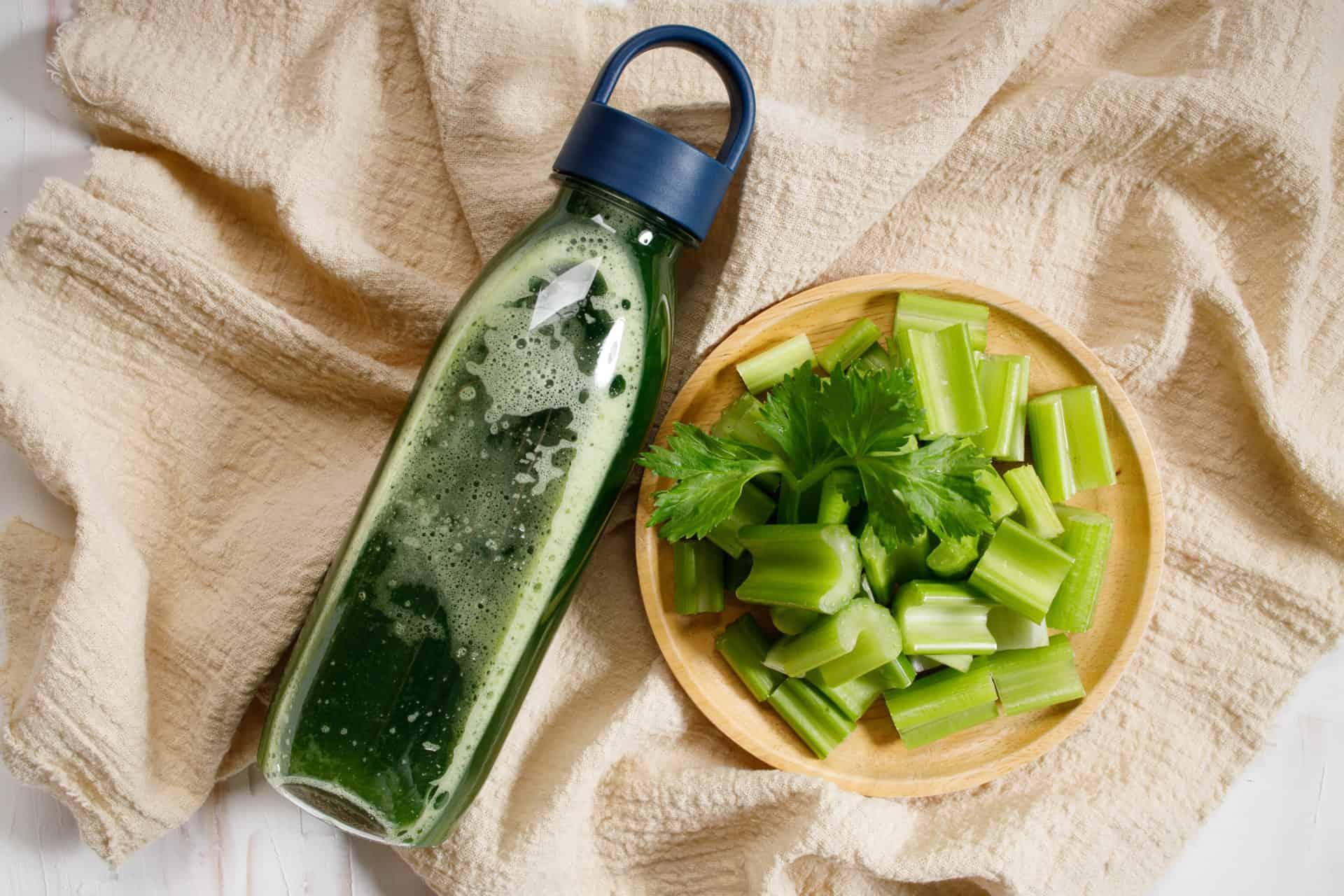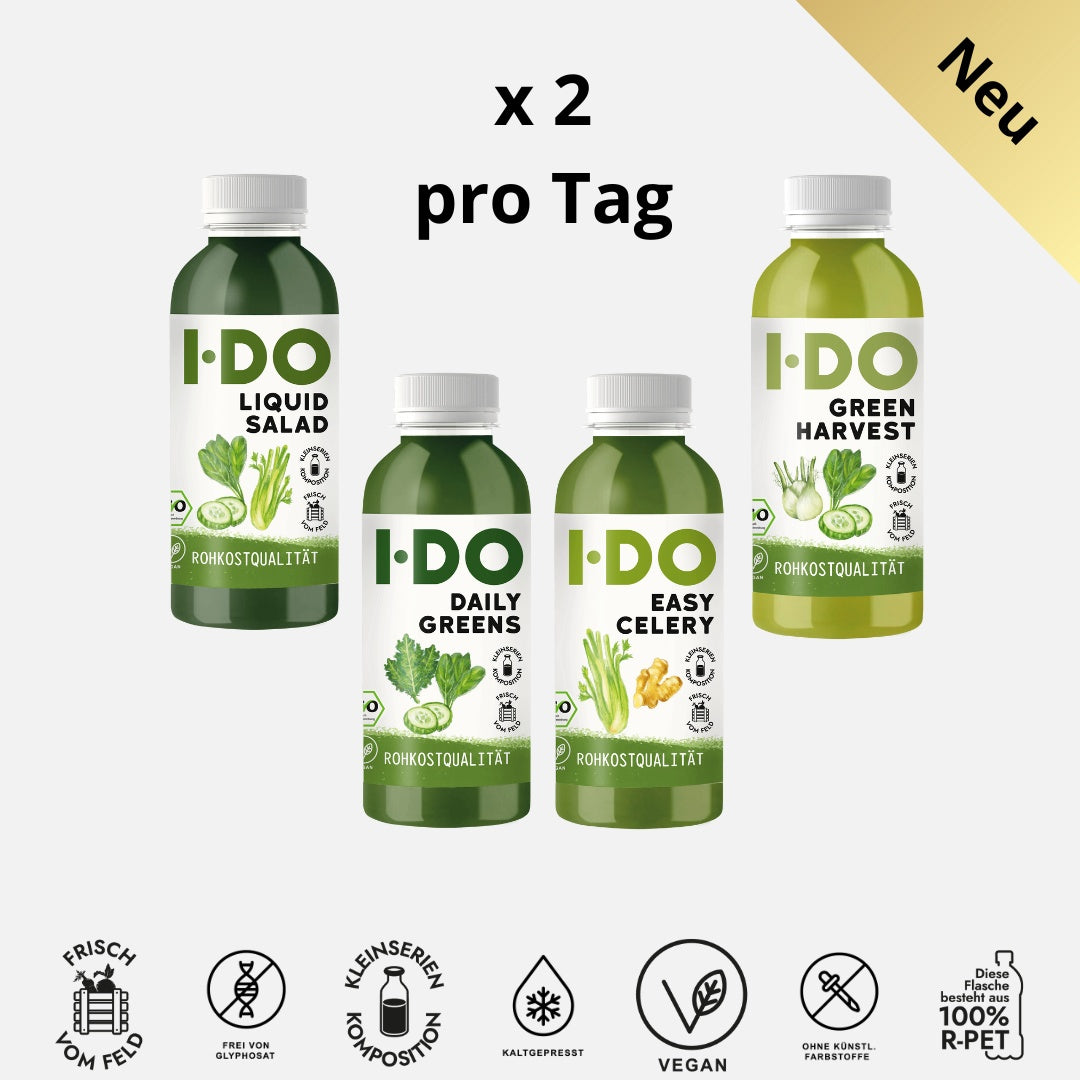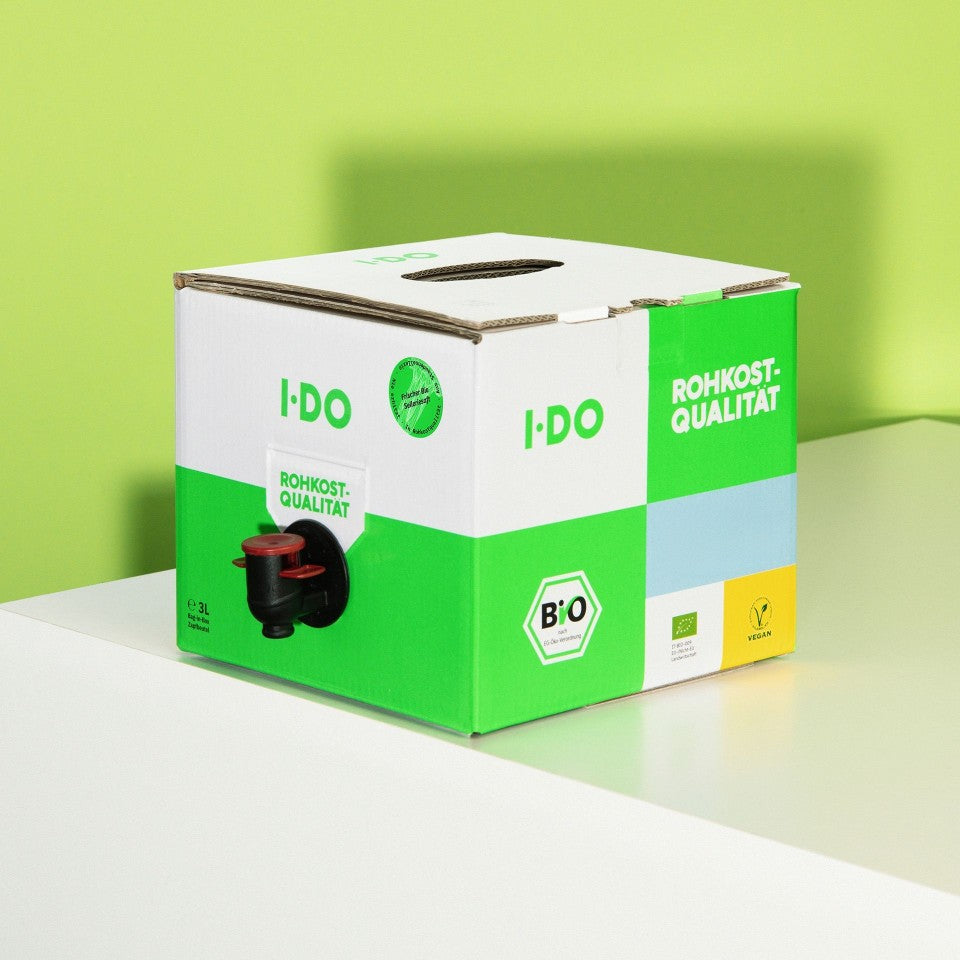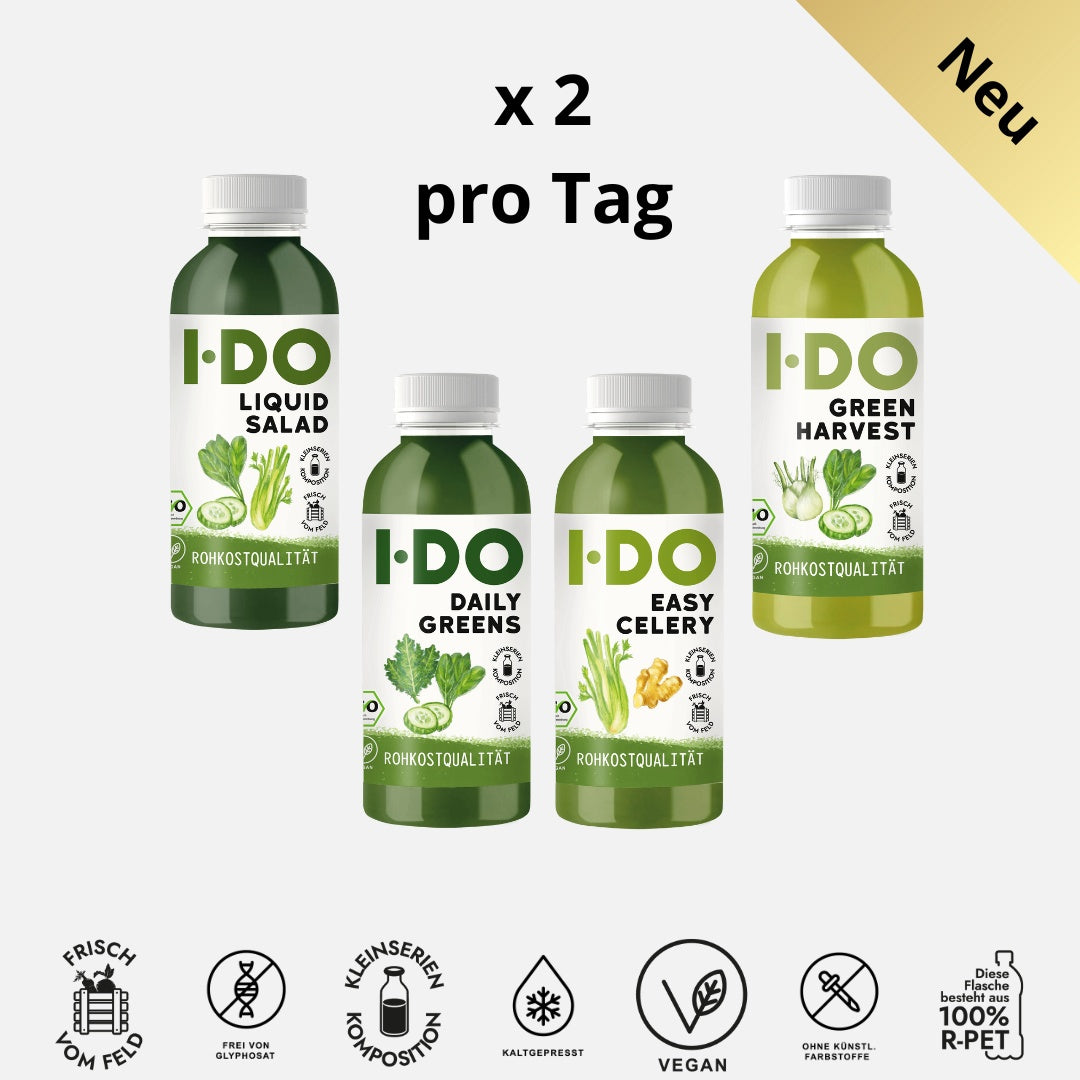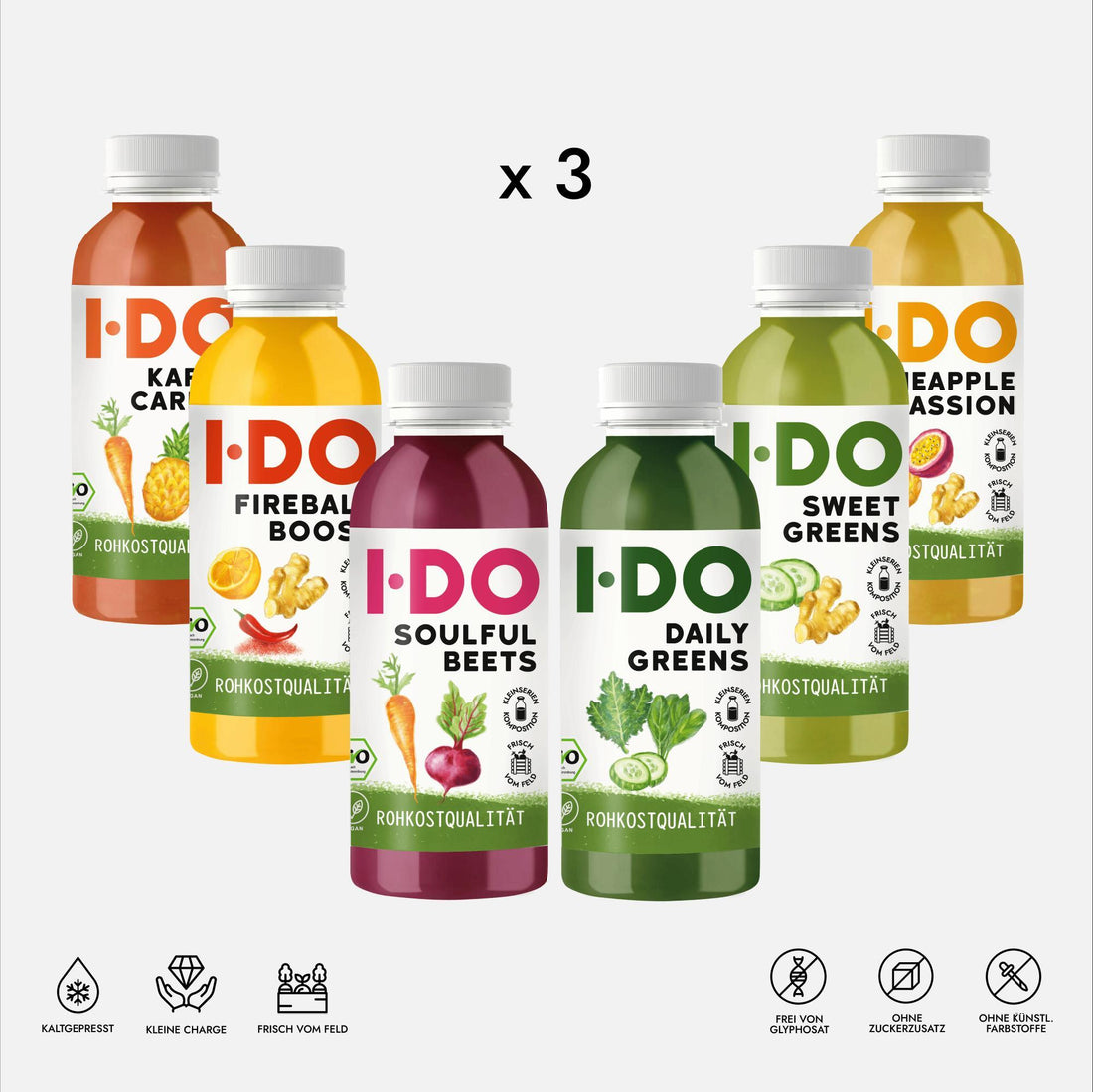Social media is full of people and companies touting the positive properties of celery juice : boosting the immune system, powerful antioxidants, restoring the adrenal glands, flushing the adrenals, cleansing the liver, and preventing intestinal rot, to name a few. As you might expect, these claims are far from based on solid evidence. So what does the science say about celery juice?
Disclaimer: We are and remain a food manufacturer, not a pharmaceutical company and expressly distance ourselves from any media or other health advice. Therefore, in this article we want to critically examine the emerging celery juice hype and treat the topic of celery juice - as is usual with us - from a factual, scientific perspective. This article references (8) scientific papers and checks 6 popular claims. We are constantly updating the article according to the current state of knowledge.
The prevention and treatment of numerous ailments and even chronic diseases is promoted or denied by various sides. But where does the celery juice phenomenon come from? Is it true that millions of people now swear by the healing effects of celery juice? Is there science to back up old and new claims about celery? Questions upon questions that we will try to answer in detail in this article.
Some good news right away: Celery itself is actually something delicious and drinking celery juice is usually not harmful. So if you squeeze juice from a bunch of celery every morning (or Anyone who wants to tap water is welcome to do so.
So let’s start from the beginning: With the alleged miracle vegetable himself.
What are the ingredients from celery ?
celery (Apium graveolens) is a marsh plant from the family Apiaceae , which have been cultivated as vegetables since ancient times. Celery has several long, fibrous stems that taper into leaves. Under the ground it forms a thick tuber, which is used primarily as an ingredient in soup vegetables.
Depending on where it is grown and the variety used, either its stems, leaves or tubers are traditionally eaten and used in cooking. Celery seeds are also used as a spice, and its extracts have long been used in herbal medicine.
The most common commercial variety in North America is celery, while in Europe the variety celeriac (also known as celery root), Apium graveolens var. rapaceum , is popular.
In Asia, leaf celery (Chinese celery, Apium graveolens var. secalinum ) in swampy areas. It is most likely the oldest cultivated form of celery.
According to the USDA (the American food safety agency that has been testing and standardizing the nutritional content of raw fruits and vegetables for decades), 100 g of celery contains approximately:
- water 95 g
- Energy 18 kcal
- Protein 1.18 gm
- Fat 0
- Carbohydrates 3.53 gm
- fiber 1.2 gm
- sugar 1.8 gm
- Calcium 40 mg
- Iron 0
- Potassium 260 mg
- Sodium 82 mg
- Vitamin C 3.1 mg
- Carotene, beta 270 µg
- Vitamin A 440 IU
- Lutein + Zeaxanthin 283 µg
- Vitamin K 29.3 µg
- Kaempferol 0.2 mg
- Quercetin 0.4 mg
- Apigenin 2.9 mg
What is particularly striking is the high sodium content and the beta carotene, which is particularly prevalent in the bitter leaves.
Where does so-called true celery before?
Celery plants and celery tubers are native to Europe, North Africa, Madeira, the Canary Islands, Yemen, West Asia, Central Asia and the Caucasus region. [WIKIPEDIA SOURCE] It was probably cultivated in the Mediterranean region . The natural habitat of the wild form is assumed to be saline, moist to swampy soils in the coastal areas of the Mediterranean countries. It occurs there in communities of the Agropyro-Rumicion association. [WIKIPEDIA SOURCE]
In Central Europe, the wild form only occurs in inland salt flats . It only inhabits moist to wet, nutrient-rich, saline mud soils in the hilly altitude zone . Its status in the German federal states lies between "highly endangered" and "extinct". In Austria, the wild form, if it ever existed, is extinct. [WIKIPEDIA SOURCE]
celery juice myths
Although celery and celery juice have been around for thousands of years and celery in particular has been known as a medicinal plant for thousands of years, one can see renewed popularity especially Anthony William William, self-proclaimed “medical medium” and “originator” of the “Global Celery Juice Movement”, has been recommending celery juice since his childhood (1976).
William, who claims he diagnosed his — symptom-free — grandmother with lung cancer when he was four years old (which was allegedly confirmed by medical tests), says he was “born with the unique ability […| to spirit of compassion who provides him with extraordinarily accurate health information that is often far ahead of its time.”
William is the author of four books to date, three of which have made it onto the New York Times bestseller list: “Medical Medium,” “Life-Changing Foods,” “Thyroid Healing,” and “Liver Rescue.” He has a huge fan base, including many well-known personalities such as Gwyneth Paltrow, Sylvester Stallone, and Robert De Niro.
William, who has no medical or scientific training, claims that celery juice is a miracle cure that, among other things, calms inflammation, especially in patients with autoimmune diseases.
He says that the body's own immune system is not the cause (contrary to the vast majority of scientists who claim pretty much the opposite), while in fact pathogenic bacteria and viruses — many of which are still undiscovered or misidentified — are the real cause.
Celery juice “starves” the pathogens that cause such diseases and other mysterious chronic ailments.
He also claims that celery juice balances the body's pH and prevents ammonia permeability (another "major unknown cause of disease"[1]). If food is not properly digested in the stomach, it will rot in the stomach." According to William:
(This) intestinal putrefaction or putrefaction creates ammonia gas, which has the ability to ghost out of your digestive tract and directly into your bloodstream. It can also enter organs such as the liver and brain. This is what I call ammonia permeability.
Millions of people are walking around with digestive health issues. One of the contributing factors is ammonia permeability, along with underlying sluggish liver problems[1].
From a rational scientific point of view, there is so much that can be considered wrong, according to the current consensus, that one does not even know where to begin. However, we will try to explain it in detail in the course of this article.
How often should one Drink celery juice?
The recommended way to drink celery juice, according to William, is as follows:
Drink about 200 to 400 milliliters of celery juice every morning on an empty stomach. Make sure it is fresh, pure celery juice with no other ingredients. Celery juice is a medicinal and not a high-calorie drink, so you still need breakfast afterward to fuel you for the day. Just wait at least 15 minutes after drinking your celery juice before eating anything else. [1]
The celery should be washed and then run through a juicer. An alternative method is to chop or blend it in a high-speed blender until it is smooth and homogenous. Strain the mixture and drink immediately. Use organic celery whenever possible.
To achieve “best results”, the juice should not be diluted with water, ice or other juice.
For those suffering from an autoimmune disease or a chronic illness, William recommends drinking 0.75l - 1l of pure celery juice per day. It can also be divided into two portions, as long as there is at least 15-30 minutes before the next meal.
There is Science for the celery juice ?
In a word: Unfortunately no. There are only a handful of articles and scientific papers in open access journals (and publications) that specifically mention celery juice. None of them involve human studies. How Dr. Merry (PhD) from Trinity College in Dublin in her contribution to HealthyButSmart.com above celery As it describes, there are a total of 1109 articles in the scientific literature that refer to celery, but only 14 of them are clinical studies and only one that specifically deals with celery juice (but not exclusively with it).
In comparison, there are over 3,000 publications on carrots, including over 90 clinical studies (including on humans).
By the way… What are sodium cluster salts?
One of Anthony William’s interesting claims is that a special property of celery juice that makes it so powerful is the presence of “undiscovered sodium cluster salts”. William explains:
These subgroups of sodium combine as one and are infused with the other chemical compounds in celery […] which are very active in healing the body. Science has not yet deconstructed or studied these cluster salts. Eventually, research will show that these cluster salts work symbiotically and systematically to flush out toxins, dead pathogens such as viruses and bacteria, and pathogenic neurotoxins and debris from every crevice of the body. [1]
We are convinced that one must such Health claims should always be taken with a pinch of salt. Especially when the person promoting them admits that scientists have not yet discovered them and that they are therefore completely unexplored. If you try to look up a definition of sodium cluster salt or sodium chloride cluster in Google, you will actually not find one at all (and we always thought Google found everything). In English, by the way, they are called Sodium Cluster Salts.
However, it is known that sodium salt (like “normal” table salt) tends to group together in water in a crystal-like manner (i.e., to cluster). “Cluster salt” can thus sometimes be seen as a background artifact in liquid chromatography – a high-resolution mass spectrometry test – appear. This is a technique used to analyze biochemical, organic and inorganic compounds and is often used in complex sample studies.
What properties such salt clusters have, or whether they can be directly linked to any specific bodily functions in our seemingly infinitely complex organism, has not yet been researched at all by modern science.
So there is simply almost no celery juice science.
Does celery juice help in chronic diseases ?
As already mentioned, there are no studies to date that look at the effect of celery juice on chronic diseases. However, there are some studies that look at a small compound, the flavonoid Apigenin , in the treatment of autoimmune diseases.
Apigenin is found in celery as well as parsley, onions, oranges, chamomile, corn, rice, tea, wheat germ and some grasses.
A review of these studies by Karisi et al. [2] showed that apigenin a certain effect on immune cells and the inflammatory substances they produce in diseases such as rheumatoid arthritis, diabetes mellitus, lupus and multiple sclerosis has.
However, all previous studies have been in vitro (in the test tube) or in animal models. There are no studies on humans. So, at present there is no evidence that celery juice is effective in treating chronic diseases actually can help.
Helps Celery juice for stomach problems ?
We could only find two studies that mentioned celery and/or celery juice in relation to gastrointestinal health. The first, by Al-Howiriny et al. [3] investigated the effect of a celery extract on the ability of indomethacin (an NSAID similar to ibuprofen) or an alcohol/salt mixture to cause stomach ulcers in rats.
It was found that rats that received either of the two above-mentioned agents had significant gastric ulcers. Rodents that were treated with 250 or 500 mg/kg celery extract prior to treatment showed protection of the gastric mucosa and reduced gastric acid secretion.
So it was well tolerated by them.
The only human study was conducted by Adzimi et al. from Iran [4]. They examined 150 patients with functional dyspepsia – a condition characterized by early satiety, feeling of fullness or bloating, and stomach pain or burning.
The patients were randomly divided into groups that received either Placebo , the anti-heartburn drug Omperprazol, or a combination of celery and Trachyspermum copticom , an ancient herb (used in the Middle East and India for intestinal and other health disorders).
The frequency and severity of the patients’ symptoms were assessed after 4 and 8 weeks of treatment, respectively. Those who received the traditional remedy showed a significant reduction in symptoms compared to those who received a placebo, similar to those who Omperprazol had received.
The main problem with this study is that the researchers did not include any groups that consumed celery or Ajwain than solo treatments. Therefore, it is not possible to determine what effect the celery component of the folk remedy actually contributed to the results – especially if Ajwain typically used for gastrointestinal symptoms.
So even for stomach problems, there is only insufficient scientific evidence that celery juice actually improves gut health.
Is celery juice good for the liver ?
Again, to our knowledge, there are no human studies examining the effects of celery or celery juice on the liver.
We found two works worth mentioning. The first, by Kolarovic et al [5], is a study that investigated whether celery juice can alter several biochemical parameters that are influenced by exposure of the liver or blood to the chemotherapeutic agent doxorubicin induced.
The parameters included the content of reduced Glutathione , activities of Catalase, xanthine oxidase, glutathione peroxidase, peroxidase and the intensity of the Lipid peroxidation . The rats were divided into three groups: control groups that received water, rats that received celery juice, and rats that received celery root juice.
Each group was further divided – one half was treated for two weeks with doxorubicin treated, the other half was not treated with doxorubicin Three days after the last doxorubicin treatment, all animals were sacrificed in this animal experiment.
A liver homogenate (essentially a “liver tissue smoothie”) or blood hemolysate (blood whose red blood cells had been broken down) was taken from the animals and examined for the parameters mentioned above.
The analysis of this data leads them to the conclusion that
Celery root and perennial juices influenced the biochemical parameters studied and showed protective effects when used with doxorubicin. [5]
The other article, by Jakovljevic et al [6], investigated the effect of celery and parsley juice on the pharmacodynamic activities of drugs that cytochrome P450 (CYPs) in their metabolism.
CYPs are proteins/enzymes that can play an important role in drug metabolism. Although CYPs are present in most tissues of the body, they are most prominent in the liver.
In this study, the authors investigated the
Effect of pretreatment of mice with juices of these plants on the action of pentobarbital and the analgesic effect of paracetamol and aminopyrine.
In mice pretreated with celery and parsley juice, a prolonged effect of pentobarbital was observed relative to the control, with statistical significance only being reached in animals pretreated with parsley.
Both pretreatments increased and prolonged the analgesic effect of aminopyrine and paracetamol, with pretreatment with parsley again being more effective.
According to the thin study base, there is slight evidence that celery juice could have a positive effect on liver function, but according to scientific standards this must also be declared insufficient.
Strengthens celery juice the gallbladder ?
Bile acids are a large family of molecules that steroidal structure and in the liver from cholesterol synthesized and together with cholesterol and phospholipids actively excreted into the bile.
Bile flowing from the liver is concentrated in the gallbladder and released into the upper intestine in response to a meal. In the intestine, bile acids act as detergents and help emulsify fats, aiding their digestion and absorption.
After participating in digestion in the small intestine, the bile acids are almost completely (95%) excreted in the distal ileum reabsorbed and then excreted by the liver portal vein blood recorded (enterohepatic circulation) .
Healthcare professionals do not typically refer to bile as “strong” or “weak.” Either there is enough bile available to perform its digestive functions or there is not.
And since, as mentioned, we do not have any human studies on the effects of celery juice on liver function, we cannot say whether it increases bile production.
The only paper that was even remotely related to celery extract and bile is from Tsi and Tan [7]. They treated mice — genetically modified to have high cholesterol — with celery juice, which resulted in a significant reduction in their blood cholesterol levels.
They did not represent an increase in cholesterol synthesis in the liver and postulated that the reduced cholesterol level was caused by increased bile acid excretion.
Again, there are no human studies to date showing that celery juice can “strengthen” bile.
Is celery juice safe?
Of course, for most people, it's perfectly fine to eat celery as a snack, as an ingredient in a recipe, or drink celery juice. It's a good, low-calorie source of numerous vitamins, minerals, and other nutrients.
However, there are some people who should not eat celery or should moderate the amount they eat (and drink). For example, people can be allergic to celery or celeriac, which is why it is also listed as an allergen in food. A Swiss group led by Ballmer-Weber [8] confirmed that “celery root is a common cause of food allergy in pollen-sensitized patients.”
The most common symptom is oral allergy syndrome (OAS), such as that seen in pollen-related food allergies. The main signs of oral allergy syndrome are swelling and itching of the lips, mouth, tongue, and throat immediately after eating certain fruits and vegetables, especially when eaten raw.
Summary
Although celery is a good, low-calorie source of many vitamins, minerals and other nutrients and phytochemicals, there is no reliable, reproducible empirical evidence from a large-scale, double-blind, placebo-controlled study in humans that would prove that celery juice It is an almost magical miracle elixir that could alleviate almost all the ailments that plague so many people.
And now the big But …
It is obvious: A seemingly unbelievable number of people worldwide now swear by celery juice and are convinced of its healing powers. How can it be that at the same time it has so far been ignored by scientific medicine? left lying left alone even though there are references to its diverse effects in naturopathy and other cultural traditions?
Anthony William can now confidently be described as the leader of an almost cult-like megatrend: He now has well over 5 million followers on the relevant social media platforms. His messages, as well as personal stories of suffering and success - resulting from the alleged healing power of celery juice - are shared by tens of thousands of followers.
Since we decided to offer the freshest celery juice possible, we have also exchanged ideas with many of you. The feedback is – admittedly – very diverse. While some people are upset about it (and accuse us) that it is not uncompromising enough. So far we add a small amount of organic lemon juice to stabilize the juice in a natural way in the interests of food safety, keyword: However, at least as many are happy to finally have a almost like homemade, cold-pressed juice Order raw celery juice in a 3l storage box and try it. Now you can You can also buy celery juice from celery in practical 250ml bottles.
After all, who has a juicer or blender at home, which usually costs several hundred euros? The desire to feed it with kilos of fresh organic celery every day and then clean the machine afterwards can quickly fade. Not to mention the price increase (probably triggered by the celery hype) and the availability problems in the off-season.
Is celery juice only one trend or is the hype justified?
The best recipe is - as is so often the case - to try it out! It doesn't matter whether you make it yourself or tap it yourself. Whether the slightly bitter, green elixir is for you and whether there is any truth in the healing promises is something everyone should find out for themselves.
One thing is certain: celery contains a variety of important nutrients and, as a typical vegetable juice with a low fructose content, can certainly not harm anyone as part of a balanced diet - as long as there is no allergy.
In any case, we would be very pleased if science also became more involved in the topic #celeryjuicebenefits We would be grateful for any information about new studies and publications that are brought to our attention.
List of sources:
- William, A. Celery Juice . Medical Medium 2018
- Kasiri, N., et al., The significant impact of apigenin on different aspects of autoimmune disease. Inflammopharmacology $V 26, 2018(6): p. 1359-1373.
- Al-Howiriny, T., et al., Gastric antiulcer, antisecretory and cytoprotective properties of celery (Apium graveolens) in rats. Pharm Biol, 2010. 48 (7): p. 786-93.
- Azimi, M., et al., Effect of Apium graveolens and Trachyspermum copticom on clinical symptoms of patients with functional dyspepsia. Avicenna journal of phytomedicine, 2017. 7 (6): p. 554-564.
- Kolarovic, J., et al., Protective effects of celery juice in treatments with doxorubicin. Molecules (Basel, Switzerland), 2009. 14 (4): p. 1627-1638.
- Jakovljevic, V., et al., The effect of celery and parsley juices on pharmacodynamic activity of drugs involving cytochrome P450 in their metabolism. Eur J Drug Metab Pharmacokinet, 2002. 27 (3): p. 153-6.
- Tsi, D. and BK Tan, The mechanism underlying the hypocholesterolaemic activity of aqueous celery extract, its butanol and aqueous fractions in genetically hypercholesterolaemic RICO rats. Life Sci, 2000. 66 (8): p. 755-67
- Ballmer-Weber, BK, et al., Celery allergy confirmed by double-blind, placebo-controlled food challenge: a clinical study in 32 subjects with a history of adverse reactions to celery root. J Allergy Clin Immunol, 2000. 106 (2): p. 373-8


